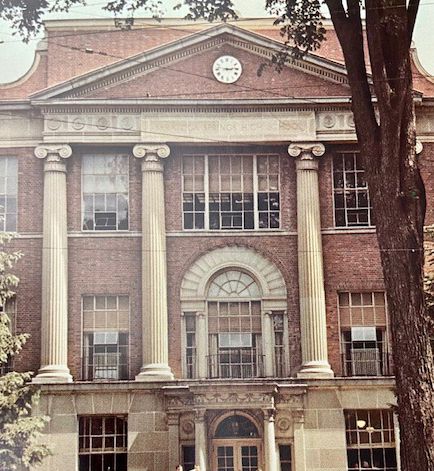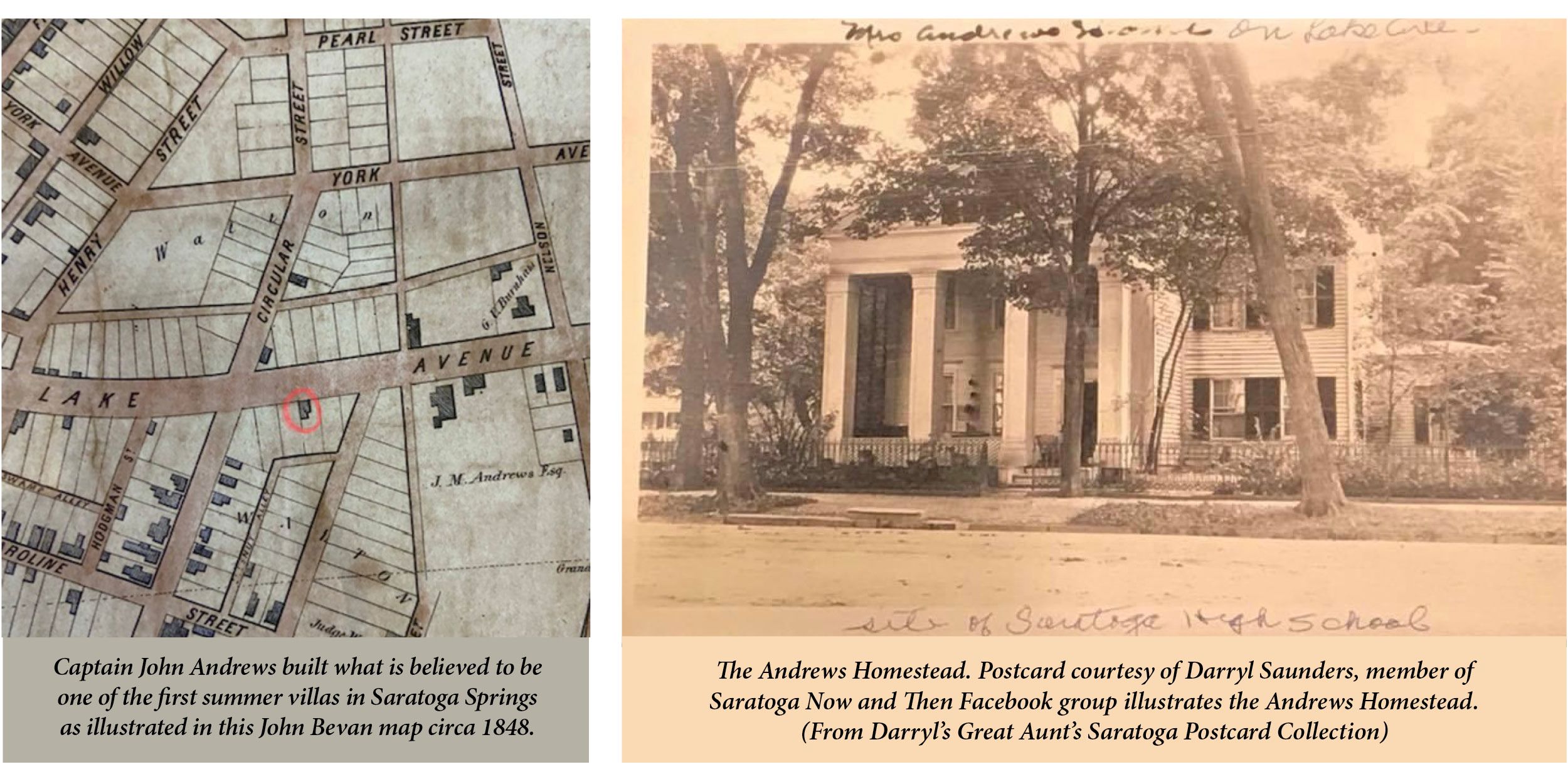WRITTEN BY CAROL GODETTE | PHOTOS PROVIDED

ABOVE: The high school in 1955.
Photo courtesy of George S. Bolster Collection
"Live as long as you may, the first twenty years are the longest half of your life. They appear so while they are passing; they seem to have been so when we look back on them; and they take up more room in our memory than all the years that succeed them."
- Robert Southey, poet
The school we today know as Lake Avenue Elementary has inspired generations of memories. Set in the heart of Saratoga Springs, between Marion Place and Regent Street, this spot has been an incubator for success.
The property, purchased in the 1840s, became the Andrews Homestead. The Andrews men had distinguished military careers. Captain James Madison Andrews fought on the front lines of the Civil War and became an active agent of the "Underground Railroad." A 1911 H. B. Settle photograph shows the Anderson attic, complete with a bed, candle, fireplace, and cooking utensils to hide southern slaves.
Captain Andrews' son, Colonel James M. Andrews Jr., graduated from West Point, became a lieutenant in the Spanish American War, and later commanded the 27th Division in the World War.
The wood-framed summer "cottage"-style house was reportedly the first villa erected for a summer residence. Other cottages that followed - and remain today - are in keeping with the style and size of the Andrews Homestead. After Mrs. Andrews' death, James and his sister, Ella Breckenridge, became executors of their mother's will. On August 11, 1922, they sold the Andrews Homestead to the Board of Education of Saratoga Springs for $13,195. Colonel Andrews' childhood home was razed, and the construction of a new three-story brick high school began in 1923.
Dedicated on November 25, 1924, the school housed the superintendent's office, as well as students from grades 9-12. The building and its experiences yielded generations of fond school memories - dances, after-school clubs, successful sports teams, and a beloved faculty.
Locals who attended high school in the ‘50s and ‘60s remember firm-handed principal John Sexton. His daughter, Elizabeth, recalls, "Claude Van Wie was superintendent and did NOT want my father to be principal.
My father's office was on the right as you came in the front door, and Van Wie's office was on the left. In art school, I did a painting of Saratoga High at night and Van Wie's office was dark, but my father's was lit up. My father spent many evenings working late, just to get it right."
The Recorder Yearbook from Sexton's time captures a "Happy Days" time of innocence and a close-knit community. Colorful neighborhood character Bill McKelvey's booming, gravelly voice greeted students at the front door each morning. The community embraced students as they regularly ran to the Eastside Rec field for P.E. classes; they joined them to cheer for the Blue Streak’s football team on Friday nights at the Eastside field; they filled the seats of Convention Hall for basketball games; and local businesses like Nichol's garage opened their doors for metal shop classes.
Sexton retired in 1964, escaping the difficult challenges administration and students faced in the 1965-66 school year. Partly due to the July 1963 formation of the enlarged Saratoga City School District (13 rural school districts from Wilton, Milton, and Greenfield joined our city school district), the high school and junior high school were bursting at the seams.
While waiting for the new West Avenue High School campus to open in January 1966, split sessions were necessary. Senior high students attended classes from 7:30 a.m. to 12:30 p.m. The junior high students attended classes for the second shift of the day. The 1966 Recorder yearbook eloquently describes it: "Split sessions and the transition to the new school have made this year's arrangement of activities both unique and unforgettable. This year has meant readjustment for the whole school, especially the faculty. While on split sessions, some teachers had to take all possessions usually kept in a desk and transport them in attaché cases. The result has been several cases of lopsidedness."
From January 1966 until the fall of 1972, the school operated as a junior high school. In September 1966, I was a pupil in the first class to attend sixth grade at the facility. Fellow classmate Michael Prosch describes, “First and foremost, it was imposing and HUGE coming from Caroline St. School. It had multiple stories and stairways which in itself was daunting. It was the first time we were faced with dealing with a much larger population of kids from the entire district.”
We adapted to walking up two flights of stairs to our third-floor classrooms, feeling adult as we fumbled with our lockers or sat in the plush seats of the auditorium for a school-wide assembly and relished after school stops at nearby Kaye’s drugs for “Hit Parade” magazines.
Since the fall of 1972, hundreds of neighborhood elementary-aged "Lake Avenue Leopards" have identified this spot as, "my kind of school." Three excellent female principals - Rita Finnegan, Marcia Henze, and Barbara Messier - have taken the helm of the highly successful elementary school. In 2012, it was one of 19 New York State elementary schools to receive a National Blue Ribbon School Award.
Fond memories of Lake Avenue school linger. Leona Beck, a mother of two college-aged boys, recalls, "I remember the first day I walked my oldest son, then 6, to his first day of school at Lake Ave. We had just moved to Saratoga, and I was nervous about the transition to our new city, new school, new everything. I didn't know that the tradition at Lake was to line up by grade, and then at the designated time, each grade would file in starting with kindergarten. As the school days wore on, we learned the traditions of "walkers" very well. We fell right into the community, and my kids still have good friends from Lake."
Writer and former Lake Avenue parent Amy Godine enthuses, "We loved this school. It was out of central casting. Long windows and old brick walls and halls that echoed and a maple gym floor that gleamed. The principal's office, right next to the front entrance. I appreciated noble teachers who were energetic, funny, focused and so ambitious for the kids. The two-square court saw even more instructive use than the classroom, steeping kids from every grade in the finer arts of adjudication and valor in disgrace before they knew what hit 'em. Lake Avenue had it all."
As the Lake Avenue school theme song proclaims, "Lake Avenue is my kind of school" for every age population it serves.
(Author's full disclosure: Lake Avenue always will hold a special place in my heart. I live in former principal Sexton's house and regularly correspond with his daughter, Elizabeth. My grown children are still close friends with many of their Lake Avenue classmates. And, I ended a memorable career with five glorious years as a teacher of fourth and fifth graders in a spot that will remain forever dear to me.)
